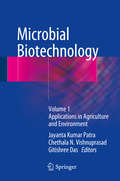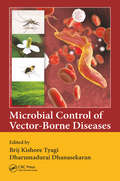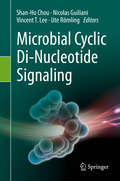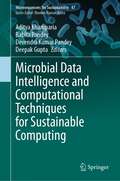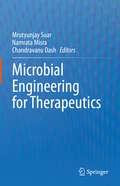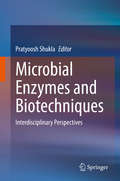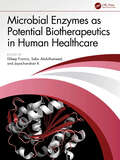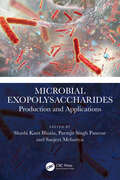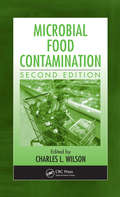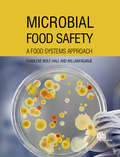- Table View
- List View
Microbial Biostimulants for Sustainable Agriculture and Environmental Bioremediation
by InamuddinToday, the agriculture industry is confronted with simultaneous issues of how to fully embrace mass production of safer food in terms of both quality and quantity. Most industries are concerned with avoiding significant levels of soil pollution and environmental threats as a result of the excessive and harmful use of synthetic products on crops. Therefore, there is a need to adopt sustainable technological innovations that can ensure the sustainability of agricultural production systems.Microbial Biostimulants for Sustainable Agriculture and Environmental Bioremediation discusses the benefits, challenges, and practical applications of eco-friendly biotechnological techniques using biostimulants derived from beneficial microorganisms. The chapters cover the use of these organisms to increase crop production, enhance soil fertility and maintain soil health, create crop and plant tolerance to different abiotic stressors, release required nutrients to the soil, increase resistance to plant pathogens/pests, improve nutrient use efficiency of crops, and rejuvenate polluted environments.FEATURES Explores the physiological, morpho-anatomical, and biochemical molecular plant rejoinders involved in stimulating crop productivity Provides information on the physiological, cellular, and molecular modes of action underlying microbial biostimulant interfaces Summarizes methods and approaches for executing microbial stimulant technology Outlines numerous environmental management and remediation strategies This book is an ideal resource for researchers, engineers, and academics working in soil science, crop science, water remediation, microbiology, and biotechnology.
Microbial Biotechnology
by Jayanta Kumar Patra Chethala N. Vishnuprasad Gitishree DasThis edited book, is a collection of 20 articles describing the recent advancements in the application of microbial technology for sustainable development of agriculture and environment. This book covers many aspects like agricultural nanotechnology, promising applications of biofuels production by algae, advancements and application of microbial keratinase, biocontrol agents, plant growth promoting rhizobacteria, bacterial siderophore, use of microbes in detoxifying organophosphate pesticides, bio-surfactants, biofilms, bioremediation degradation of phenol and phenolic compounds and bioprospecting of endophytes. This book intends to bring the latest research advancements and technologies in the area of microbial technology in one platform, providing the readers an up-to-date view on the area. This book would serve as an excellent reference book for researchers and students in the agricultural, environmental and microbiology fields.
Microbial Biotechnology: An Interdisciplinary Approach
by Pratyoosh ShuklaMicrobial Biotechnology: An Interdisciplinary Approach covers all aspects of microbial biotechnology, whilst bringing the field of functional foods and microbial bioremediation to the fore. Recounting the interdisciplinary scope of biotechnology and its discoveries, this text presents innovative ideas in the field of emerging biotechnology providing the scientific community with a much needed new resource. Acting as an important means of information for researchers working in interdisciplinary areas of research, this text: Envisages the recent ideas of novel findings in microbiology Provides insight into the various interdisciplinary research avenues Uniquely covers a diverse range of topics Presents groundbreaking new findings in key areas of modern biotechnology Enhanced and straight forward descriptions cater to the needs of researchers working in areas of bacterial exopolysaccharides, microalgal proteomics, applications of Microbial L-asparaginases, novel aspects of bioremediation, Probiotics and their impact on society, and microbial community analysis in waste water treatment techniques. It will also prove crucial reading for senior undergraduate and graduate students and professionals working in areas of modern biotechnology.
Microbial Biotechnology: Progress and Trends
by Farshad Darvishi Harzevili Hongzhang ChenIncorporates the Experiences of World-Class Researchers Microbial Biotechnology: Progress and Trends offers a theoretical take on topics that relate to microbial biotechnology. The text uses the "novel experimental experiences" of various contributors from around the world—designed as case studies—to highlight relevant topics, issues, and recent developments surrounding this highly interdisciplinary field. It factors in metagenomics and microbial biofuels production, and incorporates major contributions from a wide range of disciplines that include microbiology, biochemistry, genetics, molecular biology, chemistry, biochemical engineering, and bioprocess engineering. In addition, it also provides a variety of photos, diagrams, and tables to help illustrate the material.The book consists of 15 chapters and contains subject matter that addresses: Microbial biotechnology from its historical roots to its different processes Some of the new developments in upstream processes Solid-state fermentation as an interesting field in modern fermentation processes Recent developments in the production of valuable microbial products such as biofuels, organic acids, amino acids, probiotics, healthcare products, and edible biomass Important microbial activities such as biofertilizer, biocontrol, biodegradation, and bioremediation Students, scientists, and researchers can benefit from Microbial Biotechnology: Progress and Trends, a resource that addresses biotechnology, applied microbiology, bioprocess/fermentation technology, healthcare/pharmaceutical products, food innovations/food processing, plant agriculture/crop improvement, energy and environment management, and all disciplines related to microbial biotechnology.
Microbial Biotechnology: Volume 2. Application in Food and Pharmacology
by Jayanta Kumar Patra Gitishree Das Han-Seung ShinThis edited book, is a collection of 25 chapters describing the recent advancements in the application of microbial technology in the food and pharmacology sector. The main focus of this book is application of microbes, food preservation techniques utilizing microbes, probiotics, seaweeds, algae, enzymatic abatement of urethane in fermentation of beverages, bioethanol production, pesticides, probiotic biosurfactants, drought tolerance, synthesis of application of oncolytic viruses in cancer treatment, microbe based metallic nanoparticles, agro chemicals, endophytes, metabolites, antibiotics etc. This book highlighted the significant aspects of the vast subject area of microbial biotechnology and their potential applications in food and pharmacology with various topics from eminent experts around the World. This book would serve as an excellent reference book for researchers and students in the Food Science, Food Biotechnology, Microbiology and Pharmaceutical fields.
Microbial Cell Factories
by Deepansh Sharma and Baljeet Singh SaharanMicrobial Cell Factories is a conceptual, reference-based source including chapters covering microbial cell factories for industrial developments, microbial biotechnology, sustainable environmental solutions, agriculture practices, microorganisms in food processing, metabolites as next generation food additives/food processing, and microbial cell factories in alternative energy fuel generation. The book highlights trends and developments in the field of microbial products, written by an international team of leading academic and research scholars. Key Selling Features: Highlights trends and developments in microbial biotechnology Systematically reviews microbial cell factories Explores the potential of microbial cell derived industrial production Synthesizes information on environmental and agricultural uses of microbial biotechnology Contributions from an international team of leading scholars
Microbial Communities in Aquaculture Ecosystems: Improving Productivity and Sustainability
by Nicolas DeromeThis book sheds light on the major functions of microbial communities in aquaculture ecosystems, showing that by recycling nutrients, degrading organic matter and preventing disease outbreaks, a variety of microbes are truly beneficial to a wide range of aquaculture industries. It discusses how deteriorating environmental quality enables some microbial strains to trigger disease, describes the development of highly sustainable tools to improve water quality, and identifies crucial factors that endanger microbial homeostasis in aquaculture ecosystems.The book also covers post-antibiotic approaches for preventing and treating opportunistic microbial infections based on harnessing environmental and fish-associated microbial communities. Furthermore, it explores how manipulating and engineering these complex microbial communities using bio-agents such as probiotics, phages, natural nutritional additives, or with fine-tuned biofilters will open the door for new ways to develop a more sustainable and cost-effective aquaculture industry. Including an accessible presentation of modern high-throughput sequencing technology to identify host-microbial interactions in aquaculture ecosystems, this book is a valuable resource for scientists, aquaculture and fishery experts, sustainability enthusiasts and scholars in the areas of biology and marine agriculture.
Microbial Contamination Control in Parenteral Manufacturing (Drugs And The Pharmaceutical Sciences Ser.)
by Kevin WilliamsThis reference surveys emerging trends, concepts, and procedures used in the characterization and control of contaminants; the sterile production of traditional drugs and biologics; the design, construction, and validation of new parenteral facilities; and the monitoring of clean environments-vividly illustrating the routes by which products, proce
Microbial Contamination Control in the Pharmaceutical Industry
by Luis JimenezThis authoritative reference presents an up-to-date review of the testing methods, emerging technologies, and analytical systems and procedures used to prevent the microbial contamination of pharmaceutical processes, products, and environments. It identifies new tools for sample analysis and evaluation and the impact of these advancements on the co
Microbial Control of Vector-Borne Diseases
by Brij Kishore Tyagi Dharumadurai DhanasekaranVector-borne diseases have increasingly emerged as significant causes of human illnesses worldwide, largely due to environmental changes (deforestation), population movements (migration and travelling), international trades, and buildup of drug resistance. These are presenting major challenge to the efficacy and use of conventional tools for controlling vector-borne diseases. Therefore, use of microbial approach for the control of vector-borne diseases is gaining importance. This book comprehensively reviews vector-borne diseases and their microbial control, emphasizing majorly on ecofriendly ways of microbial control.
Microbial Cyclic Di-Nucleotide Signaling
by Shan-Ho Chou Nicolas Guiliani Vincent T. Lee Ute RömlingThis book explores the broad and diverse biological and physiological impacts of established and newly discovered cyclic di-nucleotide second messenger signaling systems, while also providing descriptions of the intriguing biochemical characteristics of multiple turnover enzymes and receptors. The respective chapters discuss the commonalities and diversity of cyclic di-GMP, cyclic di-AMP and recently discovered cyclic GMP-AMP signaling systems in manifold Gram-negative and Gram-positive bacteria. The global human pathogens Mycobacterium tuberculosis, Vibrio cholerae, Salmonella typhimurium, Escherichia coli and Streptococcus pneumoniae, the facultative human pathogen Pseudomonas aeruginosa, global plant pathogens as exemplified by Xanthomonas campestris and Burkholderia spp., and the omnipresent probiotic Lactobacilli, as well as environmentally important photoautotrophic cyanobacteria, the multicellular Myxococcus xanthus, and chemolithotrophic Acidithiobacillus are among the representatives of the microbial kingdom that are described.In turn, the various aspects of bacterial physiology affected by these signaling systems– e.g. biofilm formation and dispersal, the cell cycle, motility, virulence, production of antimicrobials, fundamental metabolism and osmohomeostasis – are discussed in detail in the context of different microorganisms. Dedicated chapters focus on the population diversity of cyclic dinucleotide signaling systems, their tendency to be horizontally transferred, the cyclic di-GMP signaling system in the social amoeba Dictyostelium, honorary cyclic (di)nucleotides, and the development of strategies for interfering with cyclic dinucleotide signaling in order to manipulate microbial behavior.Taken together, the chapters provide an authoritative source of information for a broad readership: beginners and advanced researchers from various disciplines; individuals seeking a broad overview of cyclic di-nucleotide signaling; and those who want to learn more about specific aspects. Also featuring reviews with a forward-looking perspective, the book offers a valuable source of inspiration for future research directions.
Microbial Data Intelligence and Computational Techniques for Sustainable Computing (Microorganisms for Sustainability #47)
by Deepak Gupta Aditya Khamparia Babita Pandey Devendra Kumar PandeyThis book offers information on intelligent and computational techniques for microbial data associated with plant microbes, human microbes etc. The main focus of this book is to provide an insight on building smart sustainable solutions for microbial technology using intelligent computational techniques. Microbes are ubiquitous in nature, and their interactions among each other are important for colonizing diverse habitats. The core idea of sustainable computing is to deploy algorithms, models, policies and protocols to improve energy efficiency and management of resources, enhancing ecological balance, biological sustenance and other services on societal contexts. Chapters in this book explore the conventional methods as well as the most recently recognized high-throughput technologies which are important for productive agroecosystems to feed the growing global population. This book is of interest to teachers, researchers, microbiologist, computer bioinformatics scientists,plant and environmental scientist, and those interested in environment stewardship around the world. The book also serves as an advanced textbook material for undergraduate and graduate students of computer science, biomedicine, agriculture, human science, forestry, ecology, soil science, and environmental sciences and policy makers.
Microbial Diversity, Interventions and Scope
by Neeta Raj Sharma Shiwani Guleria Sharma Mohit SharmaThis book focuses on the application of microbes in all fields of biology. There is an urgent need to understand and explore new microbes, their biological activities, genetic makeup and further opportunities for utilizing them. The book is divided into sections, highlighting the application of microbes in agriculture, nanotechnology, genetic engineering, bioremediation, industry, medicine and forensic sciences, and describing potential future advances in these fields. It also explores the potential role of microbes in space and how they might support life on a different planet.
Microbial Ecology in States of Health and Disease
by Eileen R. ChoffnesIndividually and collectively, resident microbes play important roles in host health and survival. Shaping and shaped by their host environments, these microorganisms form intricate communities that are in a state of dynamic equilibrium. This ecologic and dynamic view of host-microbe interactions is rapidly redefining our view of health and disease. It is now accepted that the vast majority of microbes are, for the most part, not intrinsically harmful, but rather become established as persistent, co-adapted colonists in equilibrium with their environment, providing useful goods and services to their hosts while deriving benefits from these host associations. Disruption of such alliances may have consequences for host health, and investigations in a wide variety of organisms have begun to illuminate the complex and dynamic network of interaction - across the spectrum of hosts, microbes, and environmental niches - that influence the formation, function, and stability of host-associated microbial communities. "Microbial Ecology in States of Health and Disease" is the summary of a workshop convened by the Institute of Medicine's Forum on Microbial Threats in March 2013 to explore the scientific and therapeutic implications of microbial ecology in states of health and disease. Participants explored host-microbe interactions in humans, animals, and plants; emerging insights into how microbes may influence the development and maintenance of states of health and disease; the effects of environmental change(s) on the formation, function, and stability of microbial communities; and research challenges and opportunities for this emerging field of inquiry.
Microbial Ecology: Microbiomes, Viromes, and Biofilms
by Bhagwan Narayan RekadwadThis book highlights the hidden world of microbiomes, viromes, and biofilms on and inside humans. Our bodies have microbiomes, which contain various bacterial communities, and viromes, which contain viruses. These invisible residents are vital to health and sickness. Infections often result from microbiome imbalances. Pathogenic bacteria can outcompete beneficial ones, causing gut dysbiosis and disease. Understanding this interaction allows probiotics to restore balance and fight infections. Microbes have a major impact on the gut-brain axis. Gut bacteria affect mood, behavior, and neurodegenerative illnesses by producing neurotransmitters and influencing brain development. The "diabesity" relationship to microbiome changes underscores its relevance in metabolic illnesses like diabetes and NAFLD. The microbiota can also affect cancer progression. Specific bacterial strains may promote tumor growth or prevent metastasis, enabling microbiome-based cancer treatments. Probiotics—live bacteria—have enormous potential. Beneficial strains can improve intestinal balance, fight infections, and treat diabetes and autoimmune conditions.Fecal transplants or co-sleeping may modify microbial ecosystems and health effects. Microbiomes, viromes, and biofilms are complex, requiring advanced tools. The makeup, function, and interactions of these communities can be characterized using next-generation sequencing (NGS). As NGS technology advances, researchers explore this hidden world, offering a future where microbiome manipulation underpins customized therapy and preventive healthcare. This area has great potential for understanding health, improving well-being, and fighting diseases in innovative ways.
Microbial Endocrinology
by Mark Lyte Primrose P.E. FreestoneMicrobial endocrinology represents a newly emerging interdisciplinary field that is formed by the intersection of the fields of neurobiology and microbiology. This book will introduce a new perspective to the current understanding not only of the factors that mediate the ability of microbes to cause disease, but also to the mechanisms that maintain normal homeostasis. The discovery that microbes can directly respond to neuroendocrine hormones, as evidenced by increased growth and production of virulence-associated factors, provides for a new framework with which to investigate how microorganisms interface not only with vertebrates, but also with invertebrates and even plants. The reader will learn that the neuroendocrine hormones that one most commonly associates with mammals are actually found throughout the plant, insect and microbial communities to an extent that will undoubtedly surprise many, and most importantly, how interactions between microbes and neuroendocrine hormones can influence the pathophysiology of infectious disease.
Microbial Endocrinology: Interkingdom Signaling in Infectious Disease and Health
by Mark LyteThis new edition highlights the numerous advances made in the field of microbial endocrinology over the last five years. Prominent among these new topics featured is the emergence of the microbiota-gut-brain axis and the role it plays in brain function. Specific focus is given to the role of microbial endocrinology in the evolutionary symbiosis between man and microbe as it relates to both health and disease. With new chapters on the microbiome and its relation to neurochemicals, this new edition brings this important volume up to date.
Microbial Endocrinology: The Microbiota-Gut-Brain Axis in Health and Disease
by Mark Lyte John F. CryanThe field of microbial endocrinology is expressly devoted to understanding the mechanisms by which the microbiota (bacteria within the microbiome) interact with the host ("us"). This interaction is a two-way street and the driving force that governs these interactions are the neuroendocrine products of both the host and the microbiota. Chapters include neuroendocrine hormone-induced changes in gene expression and microbial endocrinology and probiotics. This is the first in a series of books dedicated to understanding how bi-directional communication between host and bacteria represents the cutting edge of translational medical research, and hopefully identifies new ways to understand the mechanisms that determine health and disease.
Microbial Engineering for Therapeutics
by Mrutyunjay Suar Namrata Misra Chandravanu DashThis book highlights the recent advances in the field of microbial engineering and its application in human healthcare. It underscores the systemic and synthetic biology approaches for engineering microbes and discusses novel treatments for inflammatory bowel diseases based on engineered probiotics. The book also reviews the different options and methods for engineering microbes, ranging from recombinant DNA technology to designing microbes for targeting specific sites and delivering therapeutics. Further, it discusses genetically engineered microorganisms for smart diagnostics and describes current approaches in microbial gene editing using CRISPR-Cas9-based tools. Lastly, it summarizes the potential applications of human microbiome engineering in improving human health and explores potential strategies for scaling-up the production of engineered microbial strains for commercial purposes, as well as the challenges. Given its scope, this book is a valuable resource for students, researchers, academics and entrepreneurs interested in understanding microbial engineering for the production of commercial products.
Microbial Enzymes and Biotechniques: Interdisciplinary Perspectives
by Pratyoosh ShuklaThis book compiles the latest research on the multifarious roles of microbial enzymes, and provides an overview of microbial enzymes and biotechnologies. It discusses the use of microbial enzymes in innovative areas like nanomedicine and synthetic biotechnology, as well as the use of starch digesting enzymes and bioactive proteins as biotherapeutics, all of which have applications in modern drug discovery processes. The book also examines the concept of microbial biotransformation and protein engineering, and covers topics such as the immobilization of therapeutic enzymes, bioengineering of enzymes for bioactive compounds, the production of hydrolytic and oxidative enzymes from plant raw materials, and prebiotics and probiotics.Given its multidisciplinary scope, this book will appeal to researchers and industry experts in the fields of microbiology, biotechnology and molecular medicine.
Microbial Enzymes as Potential Biotherapeutics in Human Healthcare
by Sabu Abdulhameed Jayachandran K. Dileep FrancisThis book comprehensively reviews the diverse potential of microbial enzymes with therapeutic applications, covering their production, purification, and utilization. It examines their roles in combating various diseases, including inflammation, bacterial infections, cardiovascular conditions, and thrombotic disorders. The book highlights their pharmaceutical applications in drug formulation and bioactive compound production, with the aim of enhancing drug bioavailability, stability, and efficacy. Furthermore, the book explores the potential of microbial fibrinolytic enzymes to revolutionize treatments for thrombotic disorders. It also outlines the applications of microbial enzymes in targeting cancer cells, emphasizing their pivotal role in innovative treatment modalities. Additionally, the book presents the therapeutic applications of microbial lipases, from their use in lipid-lowering medications to the creation of lipase-based pharmaceuticals.The chapters discuss the potential of microbial uricases in managing uric-acid-related disorders and the contribution of microbial enzymes in enhancing digestion and alleviating digestive disorders. Finally, the book delves into the vital role of regulatory authorities and intellectual property rights (IPR) in the commercialization of therapeutic microbial enzymes. As such, this book serves as a valuable resource for researchers, professionals, and students of microbiology, biotechnology, and pharmaceutical sciences.Key Features: Reviews the therapeutic potential of microbial enzymes and their production and purification Examines the roles of microbial enzymes in combating a wide range of diseases, including inflammation, bacterial infections, cardiovascular conditions, and thrombotic disorders Highlights the pharmaceutical applications of microbial enzymes, focusing on drug formulation and the production of bioactive compounds to enhance drug bioavailability, stability, and efficacy Explores the therapeutic applications of microbial lipases, from lipid-lowering medications to the creation of lipase-based pharmaceuticals Presents the vital role of regulatory authorities and intellectual property rights (IPR) in the commercialization of therapeutic microbial enzymes
Microbial Exopolysaccharides: Production and Applications
by Shashi Kant Bhatia Parmjit Singh Panesar Sanjeet MehariyaThis book offers a complete coverage of microbial refinery for exopolysaccharides (EPS) production, including genetic improvements, production techniques, biotechnological applications in food, cosmetics, health and environment sector, economic perspectives, and commercialization of EPS products. It focuses on exopolysaccharides production from an organism perspective to offer a complete picture from isolation of microbes to commercialization of EPS-based products. It covers strategies for EPS production and future perspectives and the potential of microbial refinery.Features: Provides a concise introduction to the science, biology, technology, and application of exopolysaccharides (EPS) Details upstream and downstream steps in EPS production from microbial resources Acts as a complete guide from production to commercialization Explores the potential application of EPS for socioeconomical benefits Discusses the EPS applications in food, cosmetics, health, and bioremediation approach for clean and sustainable development This book is aimed at researchers and graduate students in fermentation technology, biochemical engineering, and biotechnology.
Microbial Fermentation and Enzyme Technology
by Hrudayanath Thatoi Pradeep K. Das Mohapatra Sonali Mohapatra Keshab C. MondalThe discovery of enzymes as biocatalysts has led to various biotechnological developments. The capability of enzymes to catalyse various chemical reactions both in vivo and in vitro has led them to applications in various industries, such as food, feed, pharmaceutical, diagnostics, detergent, textile, paper, leather, and fine chemical industries. Microbial Fermentation and Enzyme Technology mainly focuses on production and application of enzymes in various industries. Further, it also discusses recent developments in enzyme engineering particularly those involved in creating and improving product formations through enzyme and fermentation technology. Salient features: Includes current research and developments in the area of microbial aspects in different fields like food, chemicals, pharmaceutical, bioprocess, etc. Discusses various enzymes that are used in refinement of environmental pollutions and its application in different industrial sectors Focuses on production and application of enzymes in various industries Highlights recent developments in enzyme engineering with respect to its application in textile, pharmaceutical, nanobiotechnology, bioremediation and many other related fields.
Microbial Food Contamination
by Charles L. WilsonDivided into five parts, Microbial Food Contamination, Second Edition looks at emerging foodborne human pathogens andcomprehensively evaluates the microbiology, biochemistry, detection, risk, and threat of foodborne illness in today's global market. The first section introduces new insights into the pathogenic effect of E. coli, viral
Microbial Food Safety
by Charlene Wolf-Hall Andwilliam NganjeThis interdisciplinary textbook provides the reader with vital information and comprehensive coverage of foodborne microbial pathogens of potential risk to human consumers. It includes human pathogens and toxins originating from plants, fungi and animal products and considers their origin, risk, prevention and control. From the perspectives of microorganisms and humans, the authors incorporate concepts from the social and economic sciences as well as microbiology, providing synergies to learn about complex food systems as a whole, and each stage that can present an opportunity to reduce risk of microbial contamination. Microbial Food Safety: A Food Systems Approach explains concepts through a food supply network model to show the interactions between how humans move food through the global food system and the impacts on microorganisms and risk levels of microbial food safety. Presented in full colour throughout, this book: - Is clearly organised into easy digestible and accessible contents - Includes key questions, summaries, further reading and a glossary to aid and focus reading - Contains information boxes and numerous examples to help you review and apply the concepts covered Written by authors renowned in the field and with extensive teaching experience, this book is essential reading for upper-level undergraduate and postgraduate students of food microbiology, food safety and food science, in addition to professionals working in these areas.
